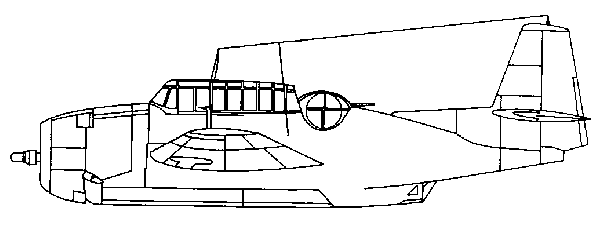Grumman TBF/TBM Avenger
Among the Grumman Company's outstanding contributions to naval
aviation, the Avenger perhaps holds the honor of being the most
versatile. It was in squadron from March 1942 until October 1954,
a shorter time than some other aircraft, but during those years
it served as a torpedo bomber, an ASW aircraft, and the Navy's
first carrier-based AEW plane; there was also a modification for
night operations, one for radar countermeasures, and another for
Carrier Onboard Delivery.
The contract of 8 April 1940 which the Navy awarded to Grumman
was for the company's first attack aircraft. Until that time,
Grumman's work for the Navy had been entirely with fighters. The
first flight of the mid-wing monoplane, three-place, torpedo bomber
occurred on 7 August 1941. During the Second World War, the Avenger
was produced by Grumman as the TBF and by the Eastern Aircraft
Division of General Motors as the TBM. Grumman produced a total
of 2,290 aircraft, Eastern produced 7,546 aircraft. The last delivery
to the Navy was made in September 1945.
The TBF-1 could carry up to 2,000 pounds of torpedoes or bombs
in the bomb bay. It had a dorsal turret with a .50 caliber gun
at the after end of the cockpit, a forward-firing .30 caliber
gun at the nose cowling and another .30 caliber gun located ventrally
facing aft. The TBF-1 was powered by a single 1700 horsepower
Wright R-2600-8 engine.
The XTBF-3 was developed to provide the Avenger with the 1900
horsepower Wright 2600-20 engine. The production version of the
XTBF-3 was never produced in its F designation but was built by
Eastern as the TBM-3. The TBM-3's range was from 1,130 to 2,530
statute miles and an average speed of 150 mph.
The TBM-3 had a length of 40 feet 11 ½ inches, a height of
16 feet 9 inches. The wing span was 54 feet 2 inches (folded size
was 19 feet).
Model Designations Accepted from Manufacturer (New Builds)
- XTBF-1: Experimental version of design.
- TBF-1: Production version of XTBF-1.
- TBF-1B: TBF-1 diverted from Navy delivery.
- TBF-1C: Same as TBF-1 but with provision for two .50 cal.
wing guns.
- XTBF-2: Test bed for Wright experimental R-2600-10 engine.
- XTBF-3: Experimental version with Wright R-2600-20 engine.
- TBM-1: Built to same specifications as the TBF-1.
- TBM-1C: Same as TBF-1C.
- XTBM-3: Experimental version with Wright R-2600-20 engine.
- TBM-3: Production development of the XTBF-3 which was similar
to the TBF-l but with improved engine, 1900 hp Wright R-2600-20.
- TBM-3E: TBM-3 equipped with ASW radar.
- XTBM-4: TBM-3 with structural strength increased to with-stand
5Gs.
Other Designations
- TBF-1CP: Same as the TBF-1C but equipped with trimetregon
camera for photo reconnaissance.
- TBF-1D: Same as TBF-1C except for special radio and radar
installation.
- TBF-1E: Same as TBF-1C but equipped with special radar.
- TBF-1J: TBF-1 converted to utility plane.
- TBF-1L: The TBF-1, TBF-1C, TBF-1D, TBF-1E but equipped with
searchlight mounted in bomb bay.
- TBM-1CP: Same as TBM-1C but equipped with trimetrogon camera
for photo reconnaissance.
- TBM-1D: Same as TBF-1D.
- TBM-1E: Same as TBM-1C but equipped with special radar.
- TBM-1J: TBM-1 converted to utility plane.
- TBM-1L: TBF-1C, TBF-1D, or TBF-1E but equipped with searchlight
mounted in the bomb bay.
- TBM-3D: Same as TBM-3 but equipped with special radar.
- TBM-3E: Same as TBM-3 but equipped with special radar (APS-4).TBM-3J:
TBM-3 converted to utility plane.
- TBM-3L: Same as TBM-3 but with searchlight mounted in bombay.
- TBM-3N: TBM-3 equipped for night operations (all-weather).
- TBM-3P: Same as TBM-3 but with trimetrogon camera for photo
reconnaissance.
- TBM-3Q: TBM-3 equipped for ECM missions.
- TBM-3R: COD version TBM-3.
- TBM-3S: ASW version of the TBM-3E.
- TBM-3S2: Same as TBM-3S with improved ASW equipment and rearrangement
of the after crew space.
- TBM-3U: Utility version of TBM-3E.
- TBM-3W: Same as TBM-3 but equipped as a special radar search
plane.
- TBM-3W2: TBM-3W with improved ASW equipment and rearrangement
of the after crew space with APS-20 radar.

Return to Aircraft Assigned
page.

